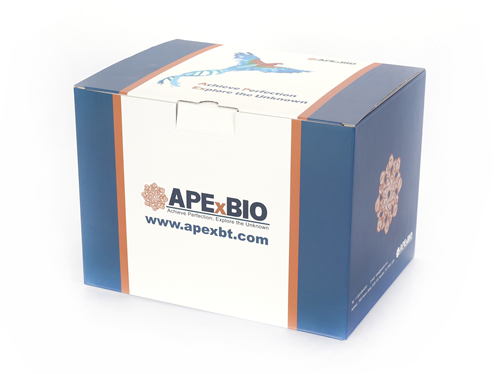- Home
- Signaling Pathways
- Metabolism
- DHFR
- Pralatrexate
Pralatrexate
| Size | Price | Stock | Qty |
|---|---|---|---|
| 10mM (in 1mL DMSO) | $171.00 | In stock | |
| 10mg | $165.00 | In stock | |
| 50mg | $303.00 | In stock | |
Pralatrexate is an inhibitor of DHFR with Ki value of 45 nM [1].
Dihydrofolate reductase (DHFR) is an enzyme that reduces dihydrofolic acid to tetrahydrofolic acid, a methyl group shuttle required for the synthesis of purines, thymidylic acid, and certain amino acids.
Pralatrexate is a DHFR inhibitor with high affinity for folylpolyglutamate synthetase (FPGS) and reduced folate carrier 1 (RFC-1), resulting in extensive internalization and accumulation in tumour cells. In 15 human cancer cell lines, pralatrexate showed antiproliferative effects with IC50 < 0.1 μM in PC3, SCC61, DU145, HT29, HOP62, SQ20B, HOP92, HEP2 and IGROV1 cells. While it showed antiproliferative effects with IC50≥ 9 μM in Colo205, HCC2998, MCF7, HCT116, OVCAR3 and MDA-MB-435 cells [2].
In MV522 human non-small cell lung cancer (NSCLC) xenograft, pralatrexate showed increased antitumor activity. In the 2 mg/kg pralatrexate-treated group, the 38% tumor growth inhibition (TGI) was observed. In NCI-H460 NSCLC xenograft, pralatrexate showed antitumor activity in a dose-dependent way. TGI of 1 mg/kg and 2 mg/kg pralatrexate-treated groups was 34% and 52%, respectively. In the two xenografts, pralatrexate resulted in weight loss, which suggested its toxicity [1].
References:
[1]. Izbicka E, Diaz A, Streeper R, et al. Distinct mechanistic activity profile of pralatrexate in comparison to other antifolates in in vitro and in vivo models of human cancers. Cancer Chemother Pharmacol, 2009, 64(5): 993-999.
[2]. Serova M, Bieche I, Sablin MP, et al. Single agent and combination studies of pralatrexate and molecular correlates of sensitivity. Br J Cancer, 2011, 104(2): 272-280.
- 1. Christoph B. Messner, Vadim Demichev, et al. "Ultra-fast proteomics with Scanning SWATH." Nat Biotechnol. 2021 Jul;39(7):846-854. PMID:33767396
- 2. Ramadurgum P, Woodard DR, et al. "Simultaneous Control of Endogenous and User-Defined Genetic Pathways Using Unique ecDHFR Pharmacological Chaperones." Cell Chem Biol. 2020;27(5):622-634.e6. PMID:32330442
| Physical Appearance | A solid |
| Storage | Store at -20°C |
| M.Wt | 477.47 |
| Cas No. | 146464-95-1 |
| Formula | C23H23N7O5 |
| Solubility | ≥23.85 mg/mL in DMSO; insoluble in H2O; insoluble in EtOH |
| Chemical Name | (2S)-2-[[4-[1-(2,4-diaminopteridin-6-yl)pent-4-yn-2-yl]benzoyl]amino]pentanedioic acid |
| SDF | Download SDF |
| Canonical SMILES | C#CCC(CC1=CN=C2C(=N1)C(=NC(=N2)N)N)C3=CC=C(C=C3)C(=O)NC(CCC(=O)O)C(=O)O |
| Shipping Condition | Small Molecules with Blue Ice, Modified Nucleotides with Dry Ice. |
| General tips | We do not recommend long-term storage for the solution, please use it up soon. |
| Cell experiment [1,2]: | |
|
Cell lines |
Cancer cell lines, NCI-H460 human NSCLC cells, MV522 human metastatic human NSCLC cells |
|
Preparation method |
The solubility of this compound in DMSO is > 23.9 mg/mL. General tips for obtaining a higher concentration: Please warm the tube at 37 ℃ for 10 minutes and/or shake it in the ultrasonic bath for a while. Stock solution can be stored below -20℃ for several months. |
|
Reacting condition |
72h |
|
Applications |
Pralatrexate showed antiproliferative activity against 15 cancer cell lines with the IC50 values ranged from 0.01 ± 0.002 μM for the prostate cancer cell line PC3 to > 350 μM for the MDA-MB-435 cell line. Pralatrexate dose-dependently inhibited the activity of DHFR. In NCI-H460 cells, treatment with pralatrexate for 15 or 60 min resulted in a short-term uptake of radiolabeled antifolates. |
| Animal experiment [1]: | |
|
Animal models |
Female nude mice (nu/nu) bearing NCI-H460 or MV522 tumor cells |
|
Dosage form |
Intraperitoneal injection, 1 and 2 mg/kg, every day×5, for two cycles of 5 days |
|
Application |
In MV522 human non-small cell lung cancer (NSCLC) xenograft, pralatrexate showed increased antitumor activity. In the 2 mg/kg pralatrexate-treated group, the 38% tumor growth inhibition (TGI) was observed. In NCI-H460 NSCLC xenograft, pralatrexate showed antitumor activity in a dose-dependent way. TGI of 1 mg/kg and 2 mg/kg pralatrexate-treated groups was 34% and 52%, respectively. In NCI-H460 and MV522 human tumor xenografts, pralatrexate resulted in dose-dependent weight loss, which suggested its toxicity. |
|
Other notes |
Please test the solubility of all compounds indoor, and the actual solubility may slightly differ with the theoretical value. This is caused by an experimental system error and it is normal. |
|
References: [1]. Izbicka E, Diaz A, Streeper R, et al. Distinct mechanistic activity profile of pralatrexate in comparison to other antifolates in in vitro and in vivo models of human cancers[J]. Cancer chemotherapy and pharmacology, 2009, 64(5): 993-999. [2]. Serova M, Bieche I, Sablin M P, et al. Single agent and combination studies of pralatrexate and molecular correlates of sensitivity[J]. British journal of cancer, 2011, 104(2): 272. |
|
Quality Control & MSDS
- View current batch:
Chemical structure

Related Biological Data

Related Biological Data












